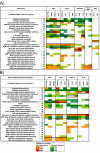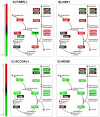Discovering the mechanism of action of novel antibacterial agents through transcriptional profiling of conditional mutants
- PMID: 15673760
- PMCID: PMC547252
- DOI: 10.1128/AAC.49.2.749-759.2005
Discovering the mechanism of action of novel antibacterial agents through transcriptional profiling of conditional mutants
Abstract
We present a new strategy for predicting novel antibiotic mechanisms of action based on the analysis of whole-genome microarray data. We first built up a reference compendium of Bacillus subtilis expression profiles induced by 14 different antibiotics. This data set was expanded by adding expression profiles from mutants that showed downregulation of genes coding for proven or emerging antibacterial targets. Here, we investigate conditional mutants underexpressing ileS, pheST, fabF, and accDA, each of which is essential for growth. Our proof-of-principle analyses reveal that conditional mutants can be used to mimic chemical inhibition of the corresponding gene products. Moreover, we show that a statistical data analysis combined with thorough pathway and regulon analysis can pinpoint the molecular target of uncharacterized antibiotics. We apply this approach to two novel antibiotics: a recently published phenyl-thiazolylurea derivative and the natural product moiramide B. Our results support recent findings suggesting that the phenyl-thiazolylurea derivative is a novel phenylalanyl-tRNA synthetase inhibitor. Finally, we propose a completely novel antibiotic mechanism of action for moiramide B based on inhibition of the bacterial acetyl coenzyme A carboxylase.
Figures


Similar articles
-
Identification and characterization of the first class of potent bacterial acetyl-CoA carboxylase inhibitors with antibacterial activity.J Biol Chem. 2004 Jun 18;279(25):26066-73. doi: 10.1074/jbc.M402989200. Epub 2004 Apr 2. J Biol Chem. 2004. PMID: 15066985
-
New class of bacterial phenylalanyl-tRNA synthetase inhibitors with high potency and broad-spectrum activity.Antimicrob Agents Chemother. 2004 Feb;48(2):525-32. doi: 10.1128/AAC.48.2.525-532.2004. Antimicrob Agents Chemother. 2004. PMID: 14742205 Free PMC article.
-
A Reinvestigation of the Role of the Sorbic Acid Tail on the Antibacterial and Anti-Tuberculosis Properties of Moiramide B.ChemMedChem. 2023 Jun 1;18(11):e202200631. doi: 10.1002/cmdc.202200631. Epub 2023 Apr 18. ChemMedChem. 2023. PMID: 36883965
-
Expression profiling in reference bacteria: dreams and reality.Genome Biol. 2000;1(4):REVIEWS1024. doi: 10.1186/gb-2000-1-4-reviews1024. Epub 2000 Oct 10. Genome Biol. 2000. PMID: 11178251 Free PMC article. Review.
-
The impact of transcriptome and proteome analyses on antibiotic drug discovery.Curr Opin Microbiol. 2004 Oct;7(5):451-9. doi: 10.1016/j.mib.2004.08.010. Curr Opin Microbiol. 2004. PMID: 15451499 Review.
Cited by
-
Improved production of andrimid in Erwinia persicina BST187 strain by fermentation optimization.BMC Microbiol. 2023 Sep 25;23(1):268. doi: 10.1186/s12866-023-02946-2. BMC Microbiol. 2023. PMID: 37749510 Free PMC article.
-
Breaking the Spell: Combating Multidrug Resistant 'Superbugs'.Front Microbiol. 2016 Feb 18;7:174. doi: 10.3389/fmicb.2016.00174. eCollection 2016. Front Microbiol. 2016. PMID: 26925046 Free PMC article. Review.
-
Perturbation-specific transcriptional mapping for unbiased target elucidation of antibiotics.Proc Natl Acad Sci U S A. 2024 Nov 5;121(45):e2409747121. doi: 10.1073/pnas.2409747121. Epub 2024 Oct 28. Proc Natl Acad Sci U S A. 2024. PMID: 39467118 Free PMC article.
-
A biosynthetic gene cluster for the acetyl-CoA carboxylase inhibitor andrimid.J Am Chem Soc. 2006 Aug 23;128(33):10660-1. doi: 10.1021/ja063194c. J Am Chem Soc. 2006. PMID: 16910643 Free PMC article.
-
Lipid-Centric Approaches in Combating Infectious Diseases: Antibacterials, Antifungals and Antivirals with Lipid-Associated Mechanisms of Action.Antibiotics (Basel). 2023 Dec 11;12(12):1716. doi: 10.3390/antibiotics12121716. Antibiotics (Basel). 2023. PMID: 38136750 Free PMC article. Review.
References
-
- Asai, K., H. Yamaguchi, C. M. Kang, K. Yoshida, Y. Fujita, and Y. Sadaie. 2003. DNA microarray analysis of Bacillus subtilis sigma factors of extracytoplasmic function family. FEMS Microbiol. Lett. 220:155-160. - PubMed
-
- Beyer, D., H. P. Kroll, R. Endermann, G. Schiffer, S. Siegel, M. Bauser, J. Pohlmann, M. Brands, K. Ziegelbauer, D. Haebich, C. Eymann, and H. Brötz-Oesterhelt. 2004. New class of bacterial phenylalanyl-tRNA synthetase inhibitors with high potency and broad-spectrum activity. Antimicrob. Agents Chemother. 48:525-532. - PMC - PubMed
MeSH terms
Substances
LinkOut - more resources
Full Text Sources
Other Literature Sources
Medical

